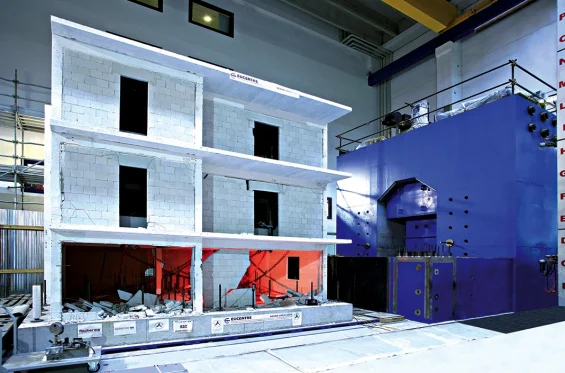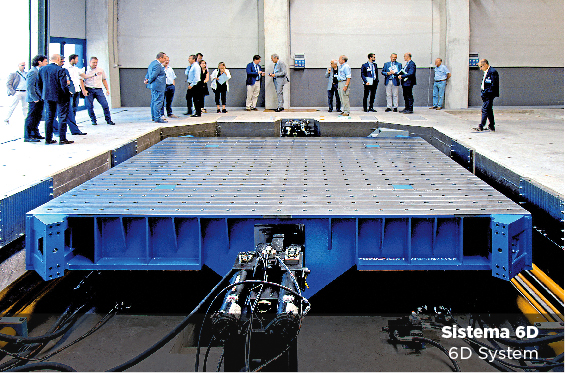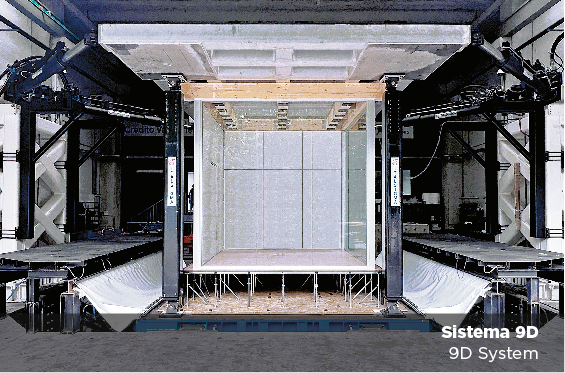Mono-axial shaking table: the infrastructure for simulating large-scale earthquakes
A high-performance mono-axial shaking table is at the heart of Eucentre’s first ShakeLab. Imagine a large 5.6 m x 7 m steel plate that can move back and forth, just as the ground would during an earthquake. This high-performance table can replicate earthquakes that have marked world history and hypothetical seismic scenarios with excellent fidelity. Its power allows the testing of entire buildings at full scale, characterised by different structural types, such as ordinary reinforced concrete structures, precast concrete structures, stone masonry structures, brick masonry, and steel and timber structures.
In addition to completing buildings on the mono-axial shaking table, it is also possible to test portions of structures rather than complex industrial elements or portions of road infrastructure.
The 6D System: analysing the dynamic interactions of non-structural elements
Since 2017, a 6-degree-of-freedom shaking table has been present at Eucentre. It represents excellence in the study of non-structural elements, i.e., those components of a building that are not part of its load-bearing framework but allow the building to function and carry out its intended activities. These elements often cause significant economic damage and, sometimes, injuries during an earthquake; for example, plants, facades, false ceilings, partitions, floating floors, air handling units, uninterruptible power supplies, sophisticated machinery, etc. The multi-axial shaking table installed in this laboratory makes it possible to test the dynamic behaviour of these elements by simultaneously subjecting them to all the stresses of an earthquake.
The name ‘6D’ refers to the six degrees of freedom with which this table is equipped. Imagine an object suspended in space: it can move back and forth, left and right, and up and down (three movements called translations), but it can also rotate on itself in three different ways (roll, pitch, and yaw, called rotations). The 6D System can reproduce all these six movements simultaneously, offering a highly realistic simulation of seismic stress. In addition, should you wish to analyse only specific components of the seismic motion, this system allows you to examine the elements of the motion that are most relevant for experimentation and not necessarily all six components.
The distinctive element of this laboratory is the combination of this six-degree-of-freedom simulator with a suspended platform with three additional degrees of freedom. This system, called 9D, allows for the effects of inter-storey displacement, i.e., the relative movement between one floor and another of a building, on the tested elements to be analysed.
The 9D System: maximum flexibility in seismic simulation
The 9D System represents the pinnacle of internationally available seismic simulation technology. By integrating the six degrees of freedom of the shaking table with three additional degrees of freedom of a suspended platform, this system can replicate in the laboratory the conditions to which a non-structural element is subjected at any plane one wishes to conceive or construct. This is particularly so because the combination of the two shaking tables makes it possible to reproduce the displacements, velocities, and accelerations of the two floors between which the object being analysed is positioned. This allows excellent flexibility in terms of experimentation because rebuilding the entire building around our non-structural element is no longer necessary. Still, it will suffice to know the vibration conditions of the floor under examination. To give an example, if we want to analyse the behaviour of an air handling unit located on the top floor of a 20-storey hospital, we will need to make an analytical model of the hospital structure subjected to an earthquake, which will tell us what the displacements, velocities, and accelerations of the floor on which the air handling unit is positioned are, and thanks to the 9D system, the movement of that particular floor on which the air handling unit to be analysed will be reproduced. This structure makes it possible to quickly consider the detailed analysis of non-structural elements on different floors without reconstructing the structure around it.
The importance of experimentation for the advancement of earthquake engineering
Eucentre’s advanced infrastructure provides crucial data for validating computational models used by engineers and developing innovative strategies for earthquake risk reduction. The ability to conduct large-scale tests makes it possible to refine technical regulations and support the design of buildings that can respond effectively to the dynamic stresses of an earthquake. For example, the results of tests conducted at Eucentre can lead to changes in building codes, making future buildings safer. In addition, testing with shaking tables can verify the behaviour of innovative construction solutions, such as using new, stronger materials or seismic isolation devices that reduce the amount of seismic energy transmitted to the building.
With its state-of-the-art research infrastructure, the Eucentre Foundation continues to play a central role in the global earthquake engineering landscape. By supporting scientific and technological progress in the field, Eucentre contributes significantly to improving the seismic safety of buildings and reducing the risk to society in the face of high-intensity seismic events. The knowledge from direct experimentation is invaluable for building a safer and more resilient future.
 Eucentre is a non-profit private law foundation whose mission is to conduct research and provide training and services in earthquake and safety engineering
Eucentre is a non-profit private law foundation whose mission is to conduct research and provide training and services in earthquake and safety engineering  Eucentre promotes science, research and innovation for the benefit of the community, offering targeted methodologies and concrete solutions for prevention, safety and resilience. It collaborates with institutions and companies to disseminate competencies for the common good.
Eucentre promotes science, research and innovation for the benefit of the community, offering targeted methodologies and concrete solutions for prevention, safety and resilience. It collaborates with institutions and companies to disseminate competencies for the common good. Shake-tables
Shake-tables Other test systems
Other test systems Eucentre carries out research activities in earthquake engineering and risk reduction through laboratory testing and numerical analysis, aiming to improve the seismic performance of structures and soils and to develop innovative seismic retrofitting techniques.
Eucentre carries out research activities in earthquake engineering and risk reduction through laboratory testing and numerical analysis, aiming to improve the seismic performance of structures and soils and to develop innovative seismic retrofitting techniques. The Foundation promotes diverse and high-quality training activities aimed at academic and professional contexts, with constantly updated and innovative programs and initiatives designed to meet the evolving needs of the sector and society
The Foundation promotes diverse and high-quality training activities aimed at academic and professional contexts, with constantly updated and innovative programs and initiatives designed to meet the evolving needs of the sector and society  Eucentre ensures communication aimed at informing institutions, professionals, and citizens about ongoing activities and projects, with the goal of disseminating useful and accessible content and knowledge. It contributes to promoting a shared and informed culture of prevention and resilience.
Eucentre ensures communication aimed at informing institutions, professionals, and citizens about ongoing activities and projects, with the goal of disseminating useful and accessible content and knowledge. It contributes to promoting a shared and informed culture of prevention and resilience.



